Many businesses are aware of the incredible potential of Facebook Ads. You can establish brand awareness, promote events, generate leads, drive sales, and build customer trust through a series of paid campaigns on the platform.
However, plenty of advertisers struggle to get the results they want with Facebook and Instagram Ads. They fail to generate clicks or conversions, or, when they do, the results simply don’t make for a good return on investment (ROI).
If you are worried your ads are underperforming, the solutions almost certainly exist.
Let’s take a look at how you can identify and fix the five signs of underperforming ads on Facebook.
How to Optimize to Avoid Facebook Ads Issues 8 Common Facebook Ad Mistakes and How to Resolve Them 1. Your Ad Hasn’t Had Any Results for the Past Three Days 2. Fewer Than 1,000 People Saw the Ad the Day Before 3. Cost Per Result Increased Over the Past Seven Days 4. People See the Same Ad Too Often 5. You Spent Less Than 70% of Your Daily Budget 6. Click-through Rate Decreased over the Past Seven days 7. Ad Reach Decreased over the Past Seven Days 8. Not All Link Clicks Resulted in Landing Page Views over the Last Three Days Start Improving Your Facebook Ads PerformanceHow to Optimize to Avoid Facebook Ads Issues
Facebook has strict rules and guidelines around their ad system, including who you can advertise to, what can and cannot be advertised, what types of images and copy can be used, and even how they are used in the live ads themselves.
For instance, it will give the broadest reach to ads containing images or video thumbnails with text covering 20% or less of the media, and may not approve ads that attribute negative traits to the viewer.
If your ads fail to meet Facebook’s quality standards, they are likely to fall short in reach and might get rejected altogether. Be sure to check your emails for the notifications - they can easily be missed.
These issues can impact your ad spend and the effectiveness of your ad campaigns, so they need to be adhered to as closely as possible.
One way to go about this is to set automated rules on Facebook. When you create these in Ads Manager, you can pause, adjust, or stop campaigns based on any number of actions.
If you want your ad to be served to the same person no more than three times, for example, you could set a rule stating that all campaigns with ad frequencies of four or higher are to be paused automatically.
Automated rules can be useful, but they are not foolproof. Trying to set them for all campaigns can be time-consuming and prone to errors that end up hurting your campaigns instead of helping them.
SEMrush’s new ad management tool in the Social Media toolkit can help with this. As well as making it easy to create and manage ads, it flags any shortcomings and tells you why. Take a look at this example:
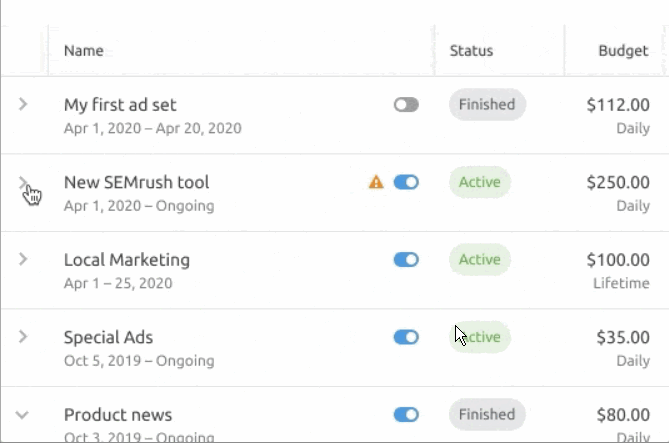
8 Common Facebook Ad Mistakes and How to Resolve Them
There are multiple signs that can indicate issues with your ads. Some can be difficult to troubleshoot, but some are easy to identify and quick to fix with the right Facebook Ads optimization tools.
Here, we’ll take a look at each one and how to address them based on advice from our Paid Social team at SEMrush.
1. Your Ad Hasn’t Had Any Results for the Past Three Days
Your ads will sometimes stop performing as expected, which can be an easy thing to miss.
A three-day stint of no results is a telltale sign. Use SEMrush to check your reach and ad spend over the past three days, and carry out a Facebook Ads performance analysis.
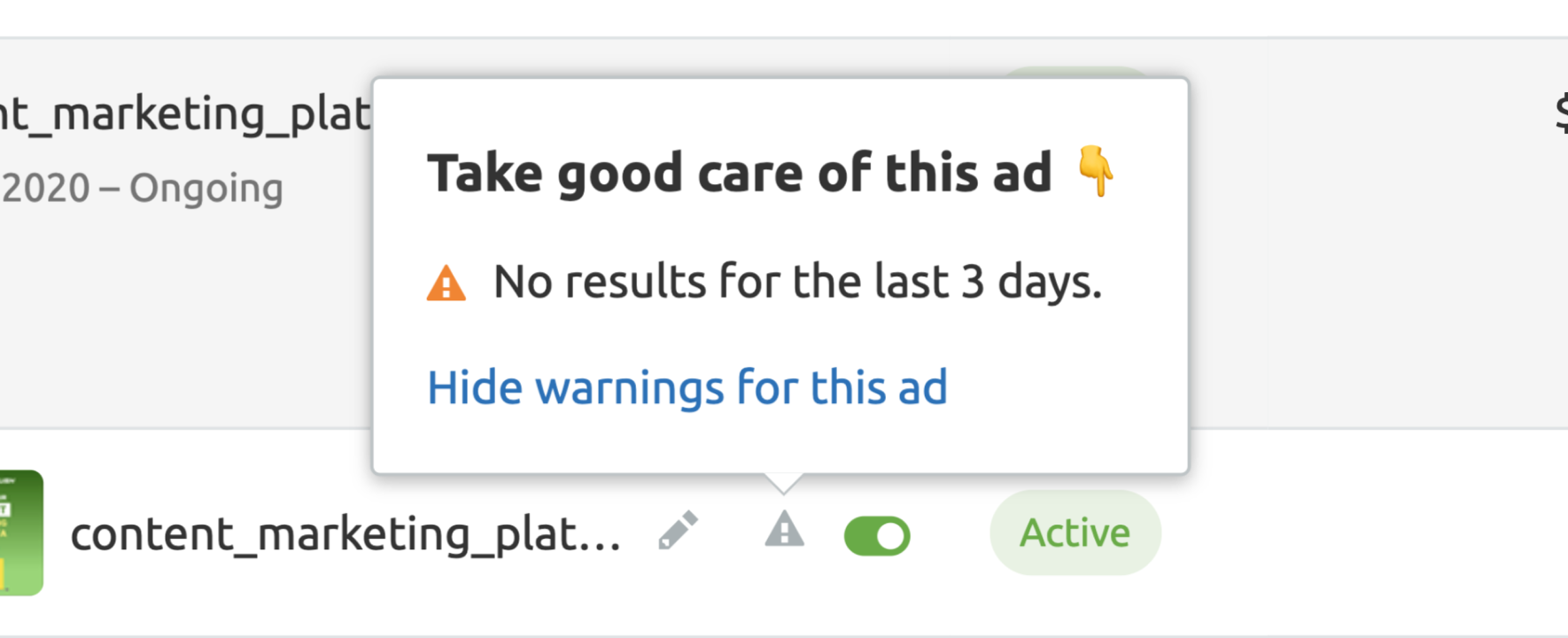
Our Social Media Ads tool will highlight your low-performing and rejected ads in the interface, allowing you to immediately identify, edit, and optimize them as needed. This will show up as a small, yellow, triangular warning sign that can be found near the status information of the ads.
As well as flagging ads that are not performing as expected, our tool will tell you exactly which potential issues need your attention. This may be that your Facebook Ads had low reach (or decreasing reach) over the past few days, or that your cost per click has increased.
The in-built filter will allow you to find ongoing and rejected ad campaigns, as well as any ads that have issues.

If your reach or ad spend are low, it is possible that you are targeting an audience that is too small, and denying yourself ad placements. Try to increase this number by expanding or fine-tuning your audience, potentially reducing the number of particularly narrow targeting criteria.
If your reach and ad spend are fine, take a look at your audience behavior through Google Analytics, and look at metrics like bounce rate, time on page, exit rate, and whether or not they are visiting other pages on your site. These metrics will indicate whether or not you are targeting the most appropriate audience.
You also want to watch for clicks and click-through rates (CTRs) on your ad campaigns to ensure that your creative is performing as expected.
Remember to look at the technical side of things as well. Make sure that the link is working and that the landing page matches the content of the ad. Ensure that event tracking is working properly; if it has been installed incorrectly, it will not be registering results.
These are all signs that might start to show after a day or two, but if three days go by without results, you will know there is an issue to investigate with the ad management tool.
2. Fewer Than 1,000 People Saw the Ad the Day Before
The management of Facebook Ads optimization is a numbers game, so identifying issues can be as simple as pinpointing curiously low numbers of views.
Use SEMrush’s Social Media toolkit to search for ad campaigns that have had decreased reach. If fewer than 1,000 people saw your ad the previous day, there are several possibilities to consider.
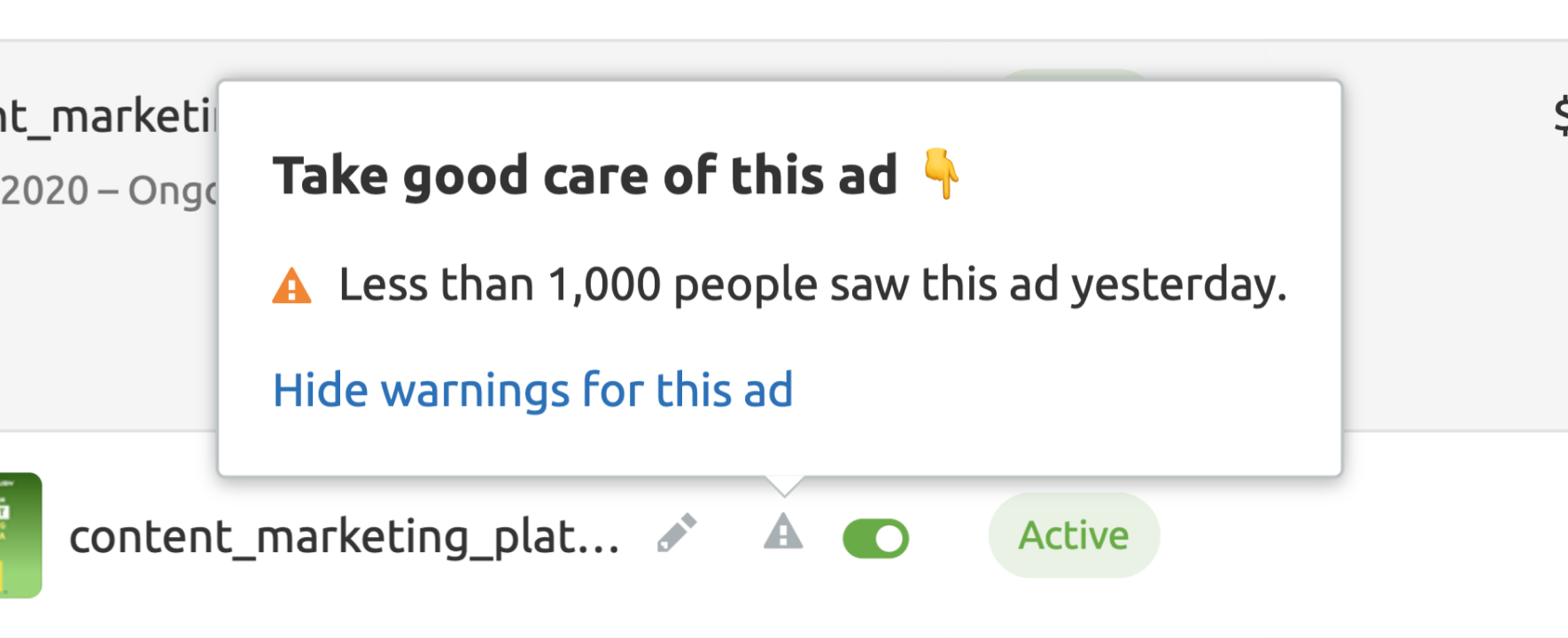
Your budget might simply be too small, for instance. If you can only afford to pay for 500 placements per day, that is all you will get, but there are ways in which you can scale your budget effectively if you are strategic about it.
Another potential issue could be that your creative may not be performing well, and may need to be modified. This could be down to the levels of text or the quality of imagery.
Split testing is a good way to work out which creative is performing best so you can adjust accordingly.
There is also the potential of reaching a spend cap, which limits how much you can spend within a certain period of time.
If you are using manual bidding, you may have set a bid cap that is too low, which could prevent you from having bids that are high enough to be competitive and assure placements.
3. Cost Per Result Increased Over the Past Seven Days
Some fluctuation in Facebook Ads costs is normal. They run on an auction-based system, so changes in the market cause costs to increase or decrease.
Costs that increase significantly within a short period of time, however, can indicate that you need to make some immediate changes to your ad campaigns.
SEMrush will automatically flag ad campaigns that experience significant increases in costs within a seven-day period so that you can quickly assess what might be driving up expenses.
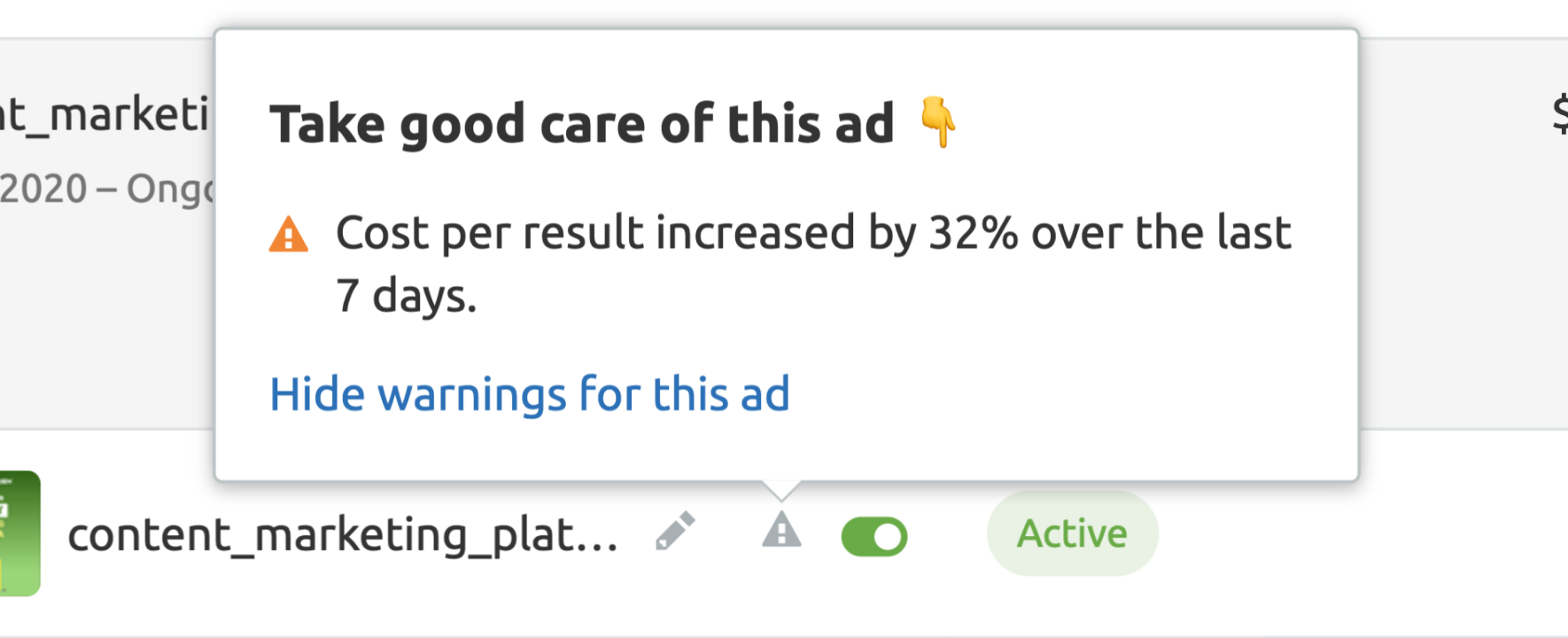
The first thing you need to do is reduce the daily budget of each individual ad campaign that has a high customer acquisition cost (CAC).
Once this is done, go back and try to identify why the costs went up in the first place. Were there changes in the audience or the ad campaign itself? Did you pause any other ads in the overall funnel? Was your frequency getting too high, or were customers hiding your ad?
Look for any changes that may be contributing to the costs, and adjust as necessary.
4. People See the Same Ad Too Often
Your frequency tells you how often an average single audience member is seeing the exact same ad.
In general, your campaigns should never have a frequency higher than three because this can significantly reduce the likelihood of conversion.
Setting this as a rule is the best way to optimize Facebook Ads in terms of frequency:
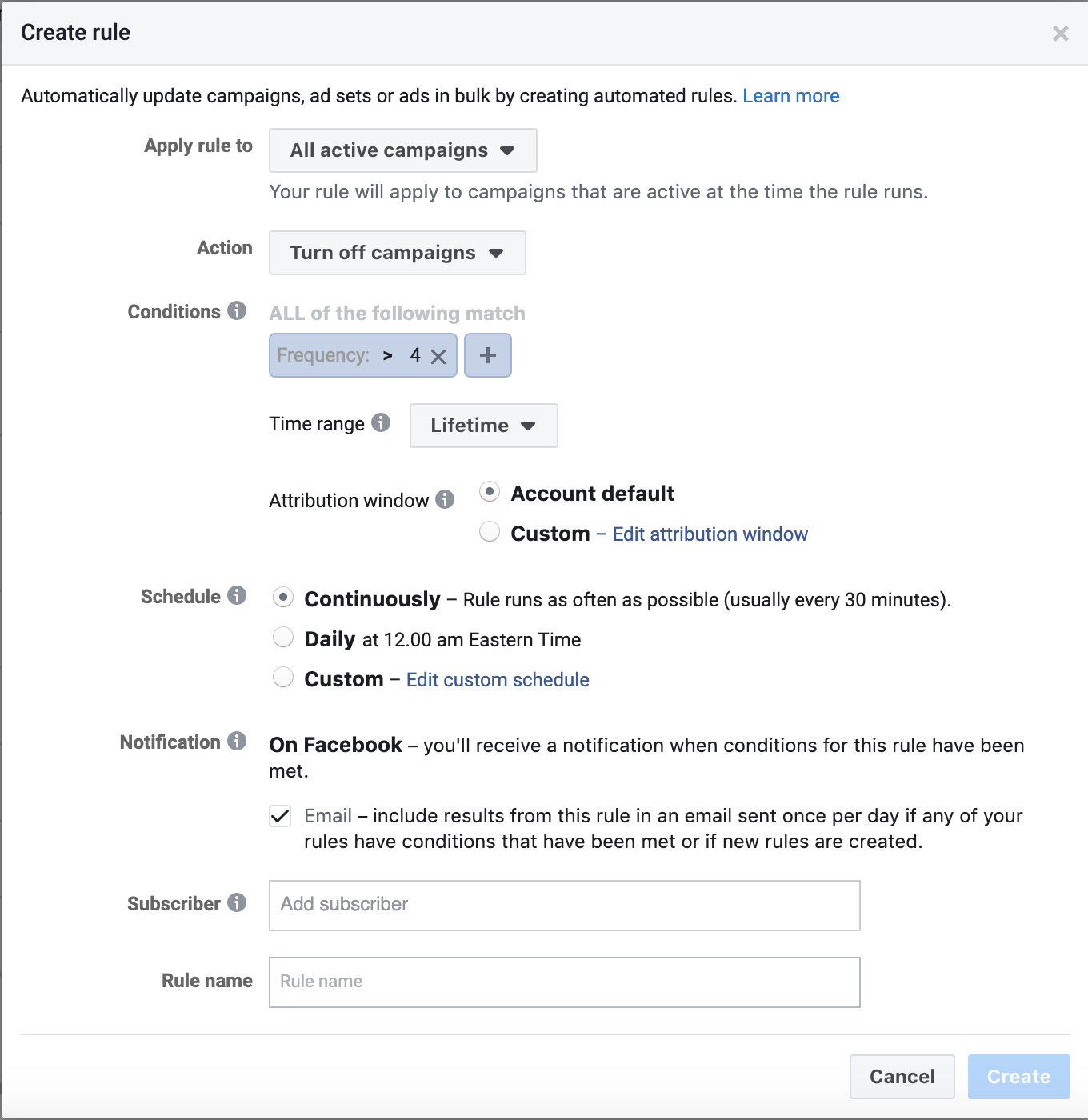
When high frequency results in ad fatigue (in other words, when repetition affects conversions), the metrics and ad spend of otherwise strong campaigns can suffer in your Facebook ad performance report.
Use our Social Media Ads tool to quickly identify any campaigns with high or rising frequencies so you can react in time to fix them.

You can also change your creative more often to present your audience with new campaigns, or expand your audience to reach more people.
5. You Spent Less Than 70% of Your Daily Budget
Setting a daily budget means you will be able to use the total ad spend available and reach as many people as possible over the course of your campaign.
It is, however, easier to notice overspending than underspending, so you might overlook the fact that your ads are not reaching their daily limits. You should typically be using at least 70% of your daily budget to benefit from your ads.
Our ad management tool will help you catch any campaigns that are falling short of their daily budget, so you can troubleshoot the problem as quickly as possible.
Be sure to track your expenses, even if you have your budget set as ‘lifetime’. Just divide your lifetime budget by a number of days and compare the obtained result to your daily expenses.
There are many potential reasons for ads underutilizing your budget:
There may be a limit on new payment methods that is preventing you from being billed correctly. If Facebook is only billing you for every $20-30 spend, the small bills can cause your ads to stop running as normal. If this is the case, try switching to your old payment method if possible.
Your billing threshold might be too low. Facebook should give you the option to increase the billing threshold from $250 to $750. For higher thresholds, you will need to manually submit a request to Facebook (these are typically resolved within a business day). Our team recommends increasing the threshold when the daily ad spend comes close to 50% of your billing threshold.
You have reached the account spending limit. Facebook will notify you when you are about to hit this cap, but this can be missed, so be sure to keep an eye on your notifications and emails.
One of your ad relevance diagnostics metrics is below average. This can include your quality ranking (previously known as your Facebook relevance score), engagement rate ranking, or conversion rate ranking. All of these metrics are used to help Facebook determine which ads to prioritize. Find out more about ad relevance diagnostics here.
Your bid level is too low. If you are using manual bidding in an attempt to cut costs, it may hinder your campaigns. Consider switching to automatic bidding, or at least increasing your manual bid. Facebook typically provides suggestions you can use for bids that will work well.
Your optimization goal cannot be reached. New accounts that have new pixels are particularly prone to this problem, because the pixels simply do not yet have enough information for true optimization. Focus on optimizing top-funnel events first so that your algorithm is able to understand the make-up of your ideal audience.
Your creative is unsuitable for your audience. If you are paying for actions that require engaging creative, such as clicks, conversions, or video views, poor results will lead to an underutilized budget. Run more split tests, and be sure to check out your competitors to see if you need to update your ads with new ideas.
For more information about optimizing Facebook Ads, you can check out Facebook’s troubleshooting ad performance guidelines here.
6. Click-through Rate Decreased over the Past Seven days
The higher your ad’s CTR is, the better it is for your campaign. Optimizing your ads to improve CTR can get you more traffic. Moreover, this metric is a good relevance indicator showing how interested your audience is in the offer. Obviously, a sharp drop in CTR is a signal that it’s time to fix your ads.
The first thing to do is to try to change your creatives and use visuals that will engage users. It would also be useful to check the Quality ranking and Engagement rate ranking metrics – Facebook will help you to determine the quality and relevance of your creatives.
Sometimes your creatives are good enough, but you show them to the wrong people. In order to obtain better results, try to expand your audience or even completely change it.
Start with the easy things: put the Expand targeting check, add more locations, try to mention a country instead of a city, or remove some values (demography, interests, etc.)
Another option is to start Facebook remarketing in order to target your ads toward past visitors to your website.
If these efforts still don’t seem to be much help, return to the research phase: try to redefine your target audience.
7. Ad Reach Decreased over the Past Seven Days
If your ad reach goes down by more than 50%, your advertising campaign is most likely failing due to some miscalculations.
Once again, try to change your creatives and find more relevant offers, eye-catching pictures, or viral videos (Facebook loves them).
A low budget also means you’ll miss out on the opportunity to show your ads to a wider audience. Increasing your budget will allow your ads to reach a wider audience in both quantitative and qualitative terms. For instance, some really valuable users we would like to target simply don’t click on ads, or lots of brands are already competing for their attention. Such users will surely ‘cost’ more.
Also, if you use manual bidding in your ads, you may be setting your bid too low. Like with budget, a low bid will reach fewer users.
Just in case, make sure you haven’t spent all your account limits. Believe it or not, it’s incredibly easy to set a spending limit and then forget about it while a campaign goes on. Double checking can save the day!
8. Not All Link Clicks Resulted in Landing Page Views over the Last Three Days
Slow page loading can lead to negative experiences for users, and troubles for businesses such as site abandonment and missed business objectives. People obviously don’t like to wait, so if you have a link in your ads, make sure the loading doesn’t take long.
SEMrush’s Social Media Ads tool checks how many clicks the link in your ad has had and relates it to the number of destination page views.
You can use our Site Audit, which checks over 120 website issues, including low page load speed.
Start Improving Your Facebook Ads Performance
Facebook Ads and Instagram Ads can be complicated, but you can remove the guesswork from the equation with the right automation tools.
As part of our Social Media toolkit, our ad management tool will warn you if any of your ads are performing poorly or have been rejected by Facebook so that you can react quickly and accordingly.
Whether this means you will have to resubmit ad campaigns or revamp individual ads, you will be able to adapt in enough time to ensure your budget does not go to waste.
Every day of lost potential could mean lost sales, so optimize your campaigns today to make the most of each and every ad you launch.
Interested in staying on top of your Facebook Ads? Start your free trial with SEMrush’s Social Media Ads tool here.
Innovative SEO services
SEO is a patience game; no secret there. We`ll work with you to develop a Search strategy focused on producing increased traffic rankings in as early as 3-months.
A proven Allinclusive. SEO services for measuring, executing, and optimizing for Search Engine success. We say what we do and do what we say.
Our company as Semrush Agency Partner has designed a search engine optimization service that is both ethical and result-driven. We use the latest tools, strategies, and trends to help you move up in the search engines for the right keywords to get noticed by the right audience.
Today, you can schedule a Discovery call with us about your company needs.
Source:





